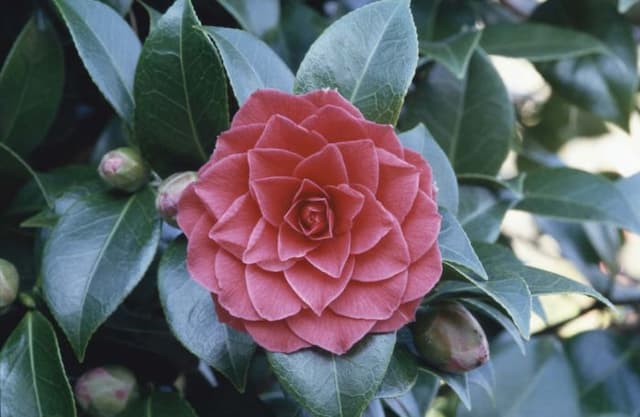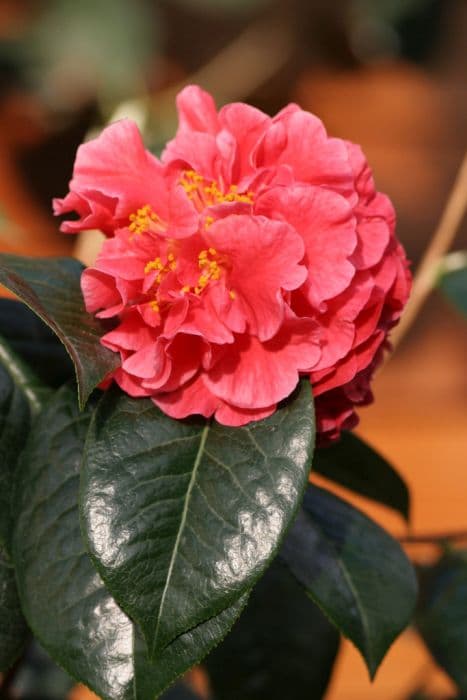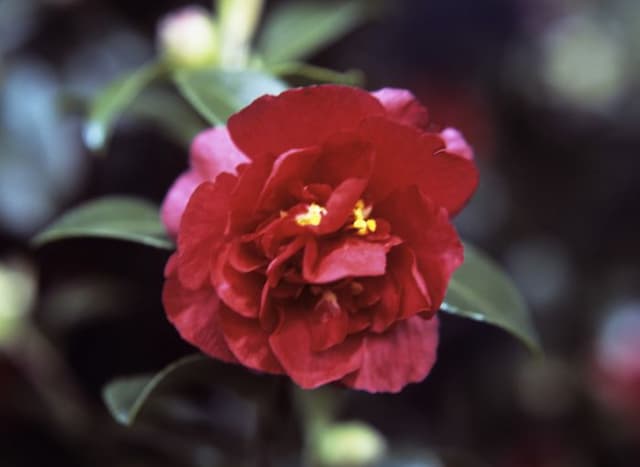Williamsii Camellia Camellia × williamsii 'Elegant Beauty'

ABOUT
'Elegant Beauty' is a popular variety of Camellia known for its stunning and attractive flowers. The plant flaunts an abundance of large, luscious blooms which usually appear from late winter through to spring, enlivening the garden when many other plants are still dormant. The flowers are semi-double to peony form, characterized by overlapping petals that almost create a ruffled look, which imbues them with a sense of softness and elegance. The petals of 'Elegant Beauty' are typically soft pink, sometimes with a deeper pink blush along the edges, creating a delicate and sophisticated color palette that can add a touch of romance to any garden space. Inside the petals, there is a proliferation of golden stamens that offer a striking contrast against the soft pink and attract the attention of pollinators. The foliage of 'Elegant Beauty' is glossy and dark green, providing a lush background that further accentuates the charm of the flowers. The leaves are leathery in texture and elliptical in shape with serrated margins, which adds to the overall textural appeal of the plant. The foliage remains evergreen throughout the year, ensuring that 'Elegant Beauty' maintains its aesthetic appeal even after the blooming period is over. 'Elegant Beauty' typically presents a bushy and well-branched habit, with the branches supporting the weight of the blooms nicely. This symmetrical growth habit and continuous greenery make it an excellent choice for gardeners looking to add structure and interest to their landscape throughout the entire year. Overall, 'Elegant Beauty' is a compelling choice for anyone who values both floral and foliage beauty in their garden.
About this plant
 Names
NamesFamily
Theaceae.
Synonyms
Williamsii Camellia, Elegant Beauty Camellia.
Common names
Camellia × williamsii 'Elegant Beauty'.
 Toxicity
ToxicityTo humans
Williamsii hybrids such as 'Elegant Beauty' are generally considered non-toxic to humans. There are no significant toxins present in the plant that would cause poisoning if ingested. Therefore, eating parts of this plant is not expected to produce any symptoms of poisoning in humans.
To pets
Williamsii hybrids like 'Elegant Beauty' are also generally safe for pets and are not known to be toxic. They do not contain significant levels of harmful substances that could lead to poisoning. Ingesting parts of this plant should not cause any symptoms of poisoning in pets. However, overconsumption of any plant material can potentially cause gastrointestinal upset, such as vomiting or diarrhea, so it is always best to prevent pets from eating plants.
 Characteristics
CharacteristicsLife cycle
Perennials
Foliage type
Evergreen
Color of leaves
Green
Flower color
Pink
Height
6-8 feet (1.8-2.4 meters)
Spread
6-8 feet (1.8-2.4 meters)
Plant type
Shrub
Hardiness zones
7-9
Native area
East Asia
Benefits
 General Benefits
General Benefits- Attractive Flowers: Produces elegant, colorful blooms which enhance the aesthetics of gardens and landscapes.
- Long Blooming Season: Offers a long flowering period, providing visual interest in the garden for several months.
- Evergreen Foliage: Retains its leaves throughout the year, ensuring a constant display of lush greenery.
- Versatility in Landscaping: Can be used in a variety of landscape designs, including as specimen plants, hedges, or container plants.
- Low Maintenance: Requires minimal pruning and care once established, making it suitable for low-maintenance gardening.
- Resilience to Pests: Generally resistant to many common pests, reducing the need for chemical treatments.
- Tolerance to Partial Shade: Can thrive in areas with filtered light, offering flexibility in garden placement.
- Attracts Pollinators: Blossoms can attract bees and other pollinating insects, supporting local ecosystems.
 Medical Properties
Medical PropertiesThis plant is not used for medical purposes.
 Air-purifying Qualities
Air-purifying QualitiesThis plant is not specifically known for air purifying qualities.
 Other Uses
Other Uses- Camellia × williamsii 'Elegant Beauty' can be used as a natural dye source, providing subtle colorings for fabrics and textiles.
- The petals of the Camellia can be used to create a delicate, aromatic tea similar to green tea, though it is not as commonly consumed.
- Camellia petals are sometimes incorporated into high-end gourmet dishes as an edible decoration for their unique texture and appearance.
- The waxy leaves of the Camellia can be polished and used in floral arrangements to add glossy, evergreen elegance.
- The timber from a mature Camellia plant is occasionally used in woodworking for inlays or small items, although this is not a widespread use due to the plant's value as an ornamental.
- Extracted oil from Camellia seeds can be used as a lubricant for tools and machinery, similar to how camellia oil is used for protecting Japanese knives.
- Dried Camellia buds can be added to potpourri mixtures, contributing a subtle scent and appearance to the blend.
- Camellia blossoms can be pressed and used in craft projects such as handmade paper, bookmarks, or laminated decorations.
- Camellia leaves can serve as a natural insecticide when crushed and sprinkled around the garden, though this use is not scientifically established.
- The strong branches of the Camellia shrub may be used in creating support structures for other plants in the garden, offering both functional and aesthetic benefits.
Interesting Facts
 Feng Shui
Feng ShuiCamellia is not used in Feng Shui practice.
 Zodiac Sign Compitability
Zodiac Sign CompitabilityCamellia is not used in astrology practice.
 Plant Symbolism
Plant Symbolism- Adoration and Devotion: Camellia, often associated with adoration, represents deep longing and devotion in the language of flowers, making it a popular gift among loved ones to express unspoken admiration.
- Perfection and Excellence: The 'Elegant Beauty' variety of camellia, as its name suggests, symbolizes the pursuit of perfection and refers to an exceptional beauty, both in character and appearance.
- Longevity and Faithfulness: With their ability to bloom for a long season, camellias signify enduring and steadfast commitment, mirroring the qualities of a long-lasting relationship.
 Water
WaterWilliamsii camellias, including 'Elegant Beauty', prefer consistent moisture and should be watered deeply and thoroughly when the top inch of soil feels dry, usually once a week. During the growing season in spring and summer, this plant might need water more frequently, especially in hot, dry weather. On average, a good rule is to provide 1 gallon of water every 7 to 10 days, adjusting as necessary for your climate and the plant's response. In winter, reduce watering to every 10 to 14 days. It’s crucial to water the camellia slowly, allowing the water to penetrate deeply into the soil to reach the roots, without overwatering and causing standing water which can lead to root rot.
 Light
LightWilliamsii camellias need a spot with dappled sunlight or partial shade to thrive. They should be protected from direct afternoon sunlight which can scorch their foliage. Morning light or filtered light beneath high-canopied trees is ideal. A north-facing or east-facing location is often best for providing the right balance of light without too much intensity.
 Temperature
TemperatureWilliamsii camellias perform best in moderate temperatures and can generally tolerate temperatures as low as 20°F and as high as 85°F. However, they prefer a temperature range between 40°F and 70°F. Camellias can suffer from cold damage if temperatures drop significantly below freezing, so providing some protection in the winter from cold winds and extreme chill can be beneficial.
 Pruning
PruningWilliamsii camellias can be pruned to maintain their shape and to remove any dead or diseased wood. The best time for pruning is just after they have finished blooming in spring. Light pruning each year helps to stimulate flowering and maintain an attractive form. Thinning the branches allows light and air to reach the inner parts of the plant, which is healthy for its growth and blooms.
 Cleaning
CleaningAs needed
 Soil
SoilWilliams' Camellia 'Elegant Beauty' thrives best in well-draining, acidic soil with a pH between 5.5 and 6.5. A mix of 1/3 peat moss, 1/3 organic potting compost, and 1/3 pine bark would be ideal, providing the necessary drainage and acidity.
 Repotting
RepottingWilliams' Camellia 'Elegant Beauty' should be repotted every 2 to 3 years, or when it outgrows its current pot, which is often noticeable when roots circle the pot, or growth slows.
 Humidity & Misting
Humidity & MistingWilliams' Camellia 'Elegant Beauty' grows well in moderate to high humidity levels; aim for 50-60% relative humidity for optimal growth.
 Suitable locations
Suitable locationsIndoor
Keep in bright, indirect light and high humidity.
Outdoor
Plant in partial shade, shelter from strong winds.
Hardiness zone
7-9 USDA
 Life cycle
Life cycleCamellia × williamsii 'Elegant Beauty', commonly known as Williamsii Camellia, begins its life cycle as a seed, which upon germination gives rise to a seedling. The seedling then enters a vegetative stage, growing leaves and stems. As it matures, it develops a woody structure and becomes an established shrub capable of flowering. Flowering typically occurs in late winter to early spring, where it produces the elegant flowers that it is named for. After pollination, the plant forms seeds, completing its reproductive cycle. Under suitable conditions, the Camellia may experience repeated cycles of vegetative growth and reproduction over many years, often living as a perennial for decades.
 Propogation
PropogationPropogation time
Spring-Early Summer
The Camellia × williamsii 'Elegant Beauty', commonly known as the Williamsii camellia, is typically propagated through semi-hardwood cuttings. The best time to take cuttings is in late summer, after the camellia has finished blooming and the new growth has begun to mature. To propagate by cuttings, a 4 to 6-inch cutting should be taken with several leaves attached. The cut end is often dipped in rooting hormone to encourage root development. The cutting is then placed in a well-draining potting mix, ensuring that at least two sets of leaves are above the soil surface. The soil should be kept consistently moist, but not waterlogged, and the cuttings should be kept in a warm, humid environment until roots develop, which can take several weeks to a few months. Once rooted, the new camellia plant can be transplanted into a larger pot or directly into the garden.









